World Bank Report: According to a World Bank survey, more women than males typically walk to work (45.4% versus 27.4%, respectively). According to the survey, women use public transportation the most in Indian cities, with an estimated 84% of their journeys being made that way.
Men and women travel inherently differently, according to the World Bank’s toolkit on “Enabling Gender Responsive Urban Mobility and Public Spaces in India.” The paper intends to offer recommendations to Indian cities on how to create public transportation systems that are more accommodating of women’s travel needs.
Also Read: 6th round of FTA negotiations between India and the UK to “kick off” today
Women frequently prefer slower forms of transportation
The survey noted that women frequently prefer slower forms of transportation since speedier options are more expensive and that they are more inclined to take price into account when travelling. Women are less likely to venture outside due to a lack of safety, the report continued.
The toolkit was created in response to a 2019 survey conducted in Mumbai with funding from the World Bank and 6,048 respondents. According to this study, between 2004 and 2019, men switched to riding two-wheelers to get to work, while women opted for taxis or auto-rickshaws, which are typically more expensive (per trip) than two-wheelers.
It includes useful tools that can assist ensure secure and welcoming public areas and public transportation for women in India by providing information to a wide range of governments as well as private or community-based organisations.
Also Read: Russia mentions India’s ‘reputation’, ‘authority’ to support India’s permanent UNSC membership
India’s female labour force participation rate is among the lowest in the world
According to a World Bank report, public transportation systems are not typically planned with women’s safety and their unique travel requirements in mind. Their access to jobs, education, and lifestyle options is severely constrained by this. At 22.8% in 2019–20, India’s female labour force participation rate is among the lowest in the world.
The research also suggests a number of transportation and public space improvements, particularly for women who frequently use non-motorized transportation, such as enough street lighting and better walking and cycling paths.
According to the survey, implementing lower fare rules can increase the number of female and non-binary passengers. Sexual harassment claims can be processed more quickly by establishing a robust grievance procedure.
According to Gerald Paul Ollivier, Lead Transport Specialist at the World Bank and co-author of the toolkit, “implementing agencies are feeling the need to address concerns of different genders and ensure safe and inclusive public spaces and public transport for women as urban mobility systems expand.” Through a collection of 50 case studies from all over India and the rest of the world, the toolkit “brings together lessons learned on the ‘what’ and ‘how,’ illuminating interventions that have worked.”
Keep watching our YouTube Channel ‘DNP INDIA’. Also, please subscribe and follow us on FACEBOOK, INSTAGRAM, and TWITTER












